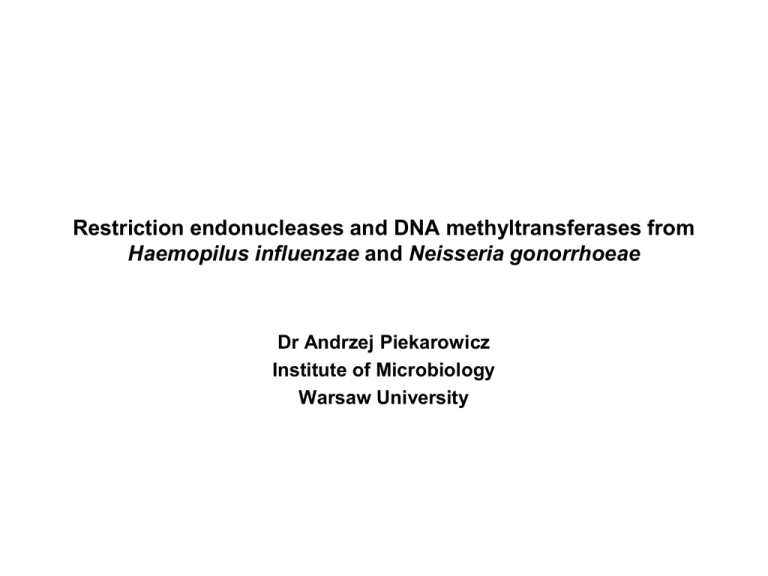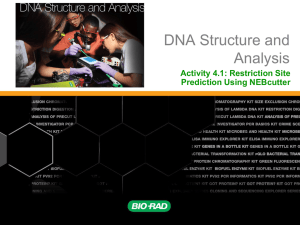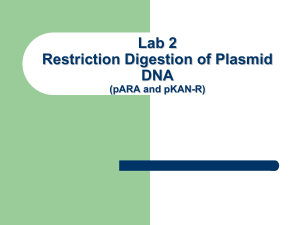Presentation File
advertisement

Restriction endonucleases and DNA methyltransferases from Haemopilus influenzae and Neisseria gonorrhoeae Dr Andrzej Piekarowicz Institute of Microbiology Warsaw University Restriction and modification systems in Haemophilus influenzae strains as determined on the on the in vivo restriction of phage HP1 (Piekarowicz and Glover 1972) (1) Each of the strains tested had different specificity except strains Rf and Re Example of genetic analysis of RM system in H. influenzae strains (Glover Piekarowicz,1974) (1) Analysis of the restrictions and modification mutants of strain Ra demonstrated existence of two independent specificity types (strains Re and Rf had also two specificity types while Rd and Rb only one) (2) proportion of the r- m+ and r- m- mutants in all strains was the same as for EcoK or EcoP1 (3) Interpretation was that r- m+ mutants arise as a results of mutation in gene hsr and r- m- of hss gene; three gene model or as two gene model in which mutation in hsm would led r- mphenotype Phase variation of the type I RM system HindI from H.influenzae Rd (Glover and Piekarowicz, 1972) • • • • ___________________________________________________________________ H. influenzae strain phenotype ___________________________________________________________________ r+ m+ r - m___________________________________________________________________ Rd wild-type 15 85 Rd 123 r + m + 90 10 Rd 200 r - m- 20 80 ____________________________________________________________________ Genetic structure of RM system HindI 1 1360627..1363116 HI_1284 translation initiation factor 2 (infB) HindI 1363195..1366362 HI_1285 type I restriction enzyme (hsdR) S.HindI 1366454..1367833 HI_1286 type I restriction/modification specificity M.HindI 1367826..1369157 HI_1287 type I modification enzyme (hsdM) 2 1369672..1370058 HI_1288 ribosome binding factor A (rbfA) Properties of the two forms of restriction endonuclease HinfIII from H. Influenzae Rf (Piekarowicz et al.,1978-1982 • • • • • • • • • _________________________________ HinfIII with AdoMet bound to it (HinfIII*) ________________________________ • • • ____________________________ HinfIII free of AdoMet (HinfIII) ____________________________ 1. Require ATP and Mg++ for restriction activity, AdoMet stimulates cleavage activity 2. In the absence and presence of AdoMet cleaves ColE1 (five sites for HinfIII) only at one site 3. Does not cleaves DNA in the presence of imido-ATP 4. Can methylates DNA in the absence of external AdoMet 5. Preferential cleavage but not methylation of spercoiled over linear DNA 6. Require minimum in cis two 5’ CGAAT 3’ sites in DNA molecule • 1. Require ATP Mg++ for restriction activity, AdoMet stimulates cleavage activity 2. In the presence of AdoMet cleaves ColE1 (five sites for HinfIII) only at one site , in the absence cleaves at five sites 3. Does not cleaves DNA in the presence of imido-ATP 4. Can not methylates DNA in the absence of external AdoMet 5. Preferential clevage but not methylation of spercoiled over linear DNA 6. Require minimum in cis two sites in DNA molecule • • • • • How to clone genes encoding DNA methyltransfreases E.coli strain AP1-200-9 helped to clone unknown genes encoding DNA Methyltransferases Nucleic Acids Res. 1991 Apr 25;19(8):1831-5. A new method for the rapid identification of genes encoding restriction and modification enzymes. Piekarowicz A, Yuan R, Stein DC. Source Institute of Microbiology, Warsaw University, Poland. Abstract We have constructed derivatives of Escherichia coli that can be used for the rapid identification of recombinant plasmids encoding DNA restriction enzymes and methyltransferases. The induction of the DNA-damage inducible SOS response by the Mcr and Mrr systems, in the presence of methylated DNA, is used to select plasmids encoding DNA methyltransferases. The strains of E. coli that we have constructed are temperaturesensitive for the Mcr and Mrr systems and have been further modified to include a lacZ gene fused to the damage-inducible dinD locus of E. coli. The detection of recombinant plasmids encoding DNA methyltransferases and restriction enzymes is a simple, one step procedure that is based on the induction at the restrictive temperature of the lacZ gene. Transformants encoding DNA methyltransferase genes are detected on LB agar plates supplemented with X-gal as blue colonies. Using this method, we have cloned a variety of DNA methyltransferase genes from diverse species such as Neisseria, Haemophilus, Treponema, Pseudomonas, Xanthomonas and Saccharopolyspora. Restriction endonucleases HaeIV 1. The HaeIV gene contains a homopolimeric tract of 10 guanosine close to stop codon 2. Deletion of one G residue from poliG tract generate frame shift mutation extending ORF for 564 bp 3. Resulting HaeIV2 variant is 188 aa longer and the enzyme has second active TRD 4. Variant HaeIV 3 was discovered by genomic analysis in another H. Influenzae strain Restriction endonucleases HaeIV All three variants show the same properties 1. Single protein has restriction and methylase activity 2. AdoMet is needed for methylase activity while only Mg ions for restriction activity 3. They differ in recognition of the specific sites but the cleavage geometry is identical in relation to the cognate sequence 8 ↓nnnnnnnnGAYN5RTCnnnnnnnnnnnnnn↓ 14 13 ↑nnnnnnnnnnnnnCTRN5YAGnnnnnnnn↑ 8 13 HaeIV 8 ↓nnnnnnnnGAYN5CTCnnnnnnnnnnnnnn↓ 14 nnnnnnnnnnnnnCTRN5GAGnnnnnnnn↑ 8 HaeIV_S2 8 ↓nnnnnnnnGAYN5CTGnnnnnnnnnnnnnn↓ 14 HaeIV_S3 13 ↑nnnnnnnnnnnnnCTRN5GACnnnnnnnn↑ 8 Restriction and modifications systems of Neisseria gonorrhoeae The combination of the „classical” purification method, cloning and genomic allowed to identified and characterized most of these enzymes from N. gonorrhoeae The genetic structure of some of the analyzed restriction-modification systems Cloning and characterization of the gene encoding a new DNA methyltransferase from Neisseria gonorrhoeae. Radlińska M, Piekarowicz A. Institute of Microbiology, University of Warsaw, Poland. Abstract A HindIII fragment of N. gonorrhoeae MS11 DNA coding for DNA methyltransferase (MTase) activity was cloned and expressed in E. coli AP1-200-9 cells. The sequence of 4681 bp was determined, and its analysis revealed two open reading frames (ORFs) sharing some similarity with known DNA MTases. ORF1 encodes an active N4mC MTase (M.NgoMV). The enzyme modifies only one strand of double stranded DNA and preferentially recognises the sequence GCCHR although it is able to methylate other sites. The exact recognition sequence cannot be precisely defined due to a relaxed specificity. The second ORF shows high homology to 5mC Mtases, but we were unable to demonstrate DNA methylating activity of its product either in vivo or in vitro. Atypical restriction endonuclease from N. meningitidis Atypical DNA Mtases encoded by Mu-like phages. 1. mom gene of Mu phage ancode an enzyme that converts adenine to N6-(1-acetoamido)adenine 2. Mu-like prophages (FluMu, Z2491and Hia5) possess a genes located in the same position as mom encoding DNA methylases with homology to N6 adenine DNA Mtases Sequence specificity of the Mom-like DNA Mtases • 5’ AB 3’ or 5’ BA 3’ • • where B + C, G, T Poly(A)- tracts are probably not methylated • Hia5 methylate 61 % of adenine residues Phase variation of RM systems • • • • • 1. Mechanism: slippage of polymerase on (a) poli G tract (b) tandem repeat of di-, tri-, four- five- nucleotides (c) single mutation change both restriction and modification activity (TypeI, Type III, Type II G) • • • 2. Consequences for RM systems: (a) loss of modification and restriction activity (b) change of specificity Phase variation of the HindI R-M system Depending on the number of guanines present in the poly(G) tract the second TRD is either expressed or not The role of PV • • • • • • 1. My studies showed dynamic changes of the restriction and modifications systems especially Type I and Type III that play a most important role as a defence system against invasion of cells by phages or plasmids 2. The main mechanism of this dynamic changes lays in the phenomenon of phase variation 3. What is the role of PV? a. The change of restriction specificty without its loss may increase the defence system of bacteria against phage and plasmid invasion and decreasing the level of possible horizontal gene transfer b. The loss of restriction activity may allow for increase of the gene transfer by „window opportunity” for acquiring of new genes increasing the speed of evolution c. evolution of bacteria and phages Acknowledgments I would like to thank to my mentors: Dr Stuart Glover Dr Thomas Bickle Dr Robert Yuan to my coworkers from other labs Dr Dan Stein To my coworkers Dr Leszek Kauc Dr Ryszard Brzezinski Dr Elzbieta Skrzypek Dr Monika Radlinska Dr Monika Adamczyk-Poplawska Dr Agnieszka Kwiatek







